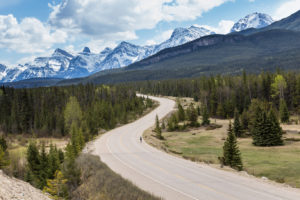During your cycling tour you’ll be riding the 230km long Icefields Parkway between Jasper and Lake Louise.
The Icefields Parkway was named for its sprawling icefields and more than 100 glaciers.
As you ride along with no roof or windows to get in your way of the views you might wonder how and why this road got built in the first place.
This matchless alpine avenue is the end result of thousands of years of human contact with the environment in this part of the Rockies.
First Nations settlers and travelers, fur-traders, explorers, and adventurers past and present have all had an impact on this world-famous route between Jasper and Banff.
Icefields Parkway Fast Facts
- The building of the road was a public works Depression-relief project.
- Construction took 9 years. It began in 1931 and finished in 1940.
- More than 2000 unemployed city men did the work.
- The men were kept in small camps that resembled forced labour camps – they earned $5/month and had to have written permission to leave camp.
- Groups worked from opposite ends of each road section and worked toward each other.
- Surveyors daily plotted the road just ahead of construction crews.
- To keep the men employed as long as possible, crews used hand tools instead of machinery.
- Heavy equipment completed the work once World War II started.
- It took close to 8 years to build 33 kilometres of road by hand from Jasper to Athabasca Falls.
- It took almost 2 years to build 14 kilometres of road from the Columbia Icefield to Big Bend.

The Icefields Parkway winds gently through the Rocky Mountains
